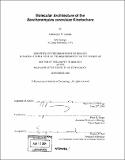Molecular architecture of the Saccharomyces cerevisiae kinetochore
Author(s)
Espelin, Christopher W., 1969-
DownloadFull printable version (14.54Mb)
Alternative title
Molecular architecture of the S. cerevisiae kinetochore
Other Contributors
Massachusetts Institute of Technology. Dept. of Biology.
Advisor
Peter Sorger.
Terms of use
Metadata
Show full item recordAbstract
(cont.) checkpoint proteins Bub lp and Bub3p are recruited to the kinetochore as part of the normal cell cycle in budding yeast, whereas Madlp and Mad2p are recruited only in response to damage to the CEN-kinetochore-MT connection. Analysis of specific S. cerevisiae kinetochore mutants indicates that attachment status is the signal recognized by the spindle checkpoint to allow the metaphase-to-anaphase transition to occur. The kinetochore is a multiprotein complex capable of simultaneously binding centromeric DNA (CEN) and microtubules (MTs). In this capacity, the kinetochore is responsible for enabling sister chromatids to become attached to the mitotic spindle, thus ensuring proper chromosome segregation. Due to its small size and simple structure, the Saccharomyces cerevisiae CEN is particularly well suited for studying kinetochore assembly and function. Analysis of S. cerevisiae Ndc lop established the binding of this kinetochore protein to the CDEII element of the CEN, forming part of the DNA-Binding layer upon which the rest of the kinetochore is assembled. Alteration of the nucleotide bases deemed important for Ndc lOp-CEN binding il vitro, have dramatic effects on chromosome segregation in vivo. Further characterization indicates that Ndc lop may also play a role in chromosome segregation at non-CEN locations. A combination of live-cell imaging, biochemical and genetic techniques were used to identify eleven novel S. cerevisiae kinetochore subunits and elucidate their roles in microtubule attachment. Chromatin Immunoprecipitation (ChIP) Assays evaluated both the range of CEN DNA bound by these kinetochore proteins and determined the interdependencies required for their association with CEN DNA. Using this data, a preliminary model of the molecular architecture of the kinetochore is beginning to emerge. Dynabead-Kinetochore Reconstitution Assays suggest an interaction between the CBF3 Complex bound to CEN DNA and Ndc80p, Cse4p, Mif2p and Amelp, adding further insight into kinetochore assembly. The spindle assembly checkpoint monitors proper bipolar attachment of sister chromatids to the mitotic spindle. Microscopy and ChIP demonstrate
Description
Thesis (Ph. D.)--Massachusetts Institute of Technology, Dept. of Biology, 2004. Includes bibliographical references.
Date issued
2004Department
Massachusetts Institute of Technology. Department of BiologyPublisher
Massachusetts Institute of Technology
Keywords
Biology.